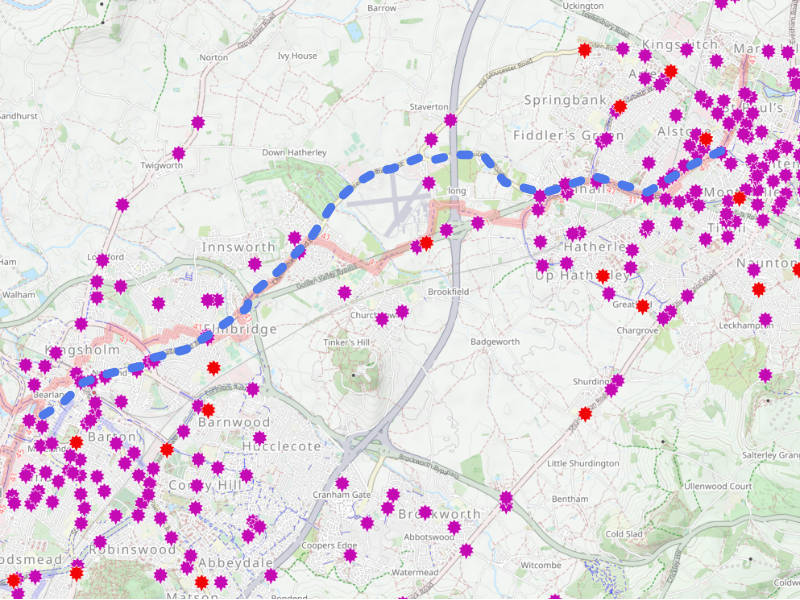What was the purpose of the consultation?
The Gloucestershire road safety policy acknowledges that the number of people killed or seriously injured on Gloucestershire’s roads has increased by 27% in recent years. This is the sixth worst outcome for casualty reduction efforts any local authority in Britain, and compares to a 52% reduction in Staffordshire (best performing), although similar to other counties in the south west which have performed equally poorly.

Recognising the very significant impact this has on individuals, families and communities across the county, and how concerns about road safety impact on the uptake of active travel, Gloucestershire County Council have produced a new Gloucestershire road safety strategy, which says they intend to pursue a ‘Vision Zero‘ approach. First implemented in Sweden in 1997, when implemented successfully, it can transform outcomes making streets and roads safer for all.
“Underlying the Vision Zero strategy is the Safe System – a holistic safety approach that shifts responsibility from the people using roads to the people designing them, integrating core management and action areas to create a safe mobility system forgiving of human error.”
VISIONZEROCHALLENGE.ORG
Gloucestershire’s response to this challenge is grouped under nine themes, which cover leadership and data, as well as a specific section on improving the safety of cycling. The proposals in this area include;
- Supporting the delivery of the LCWIPS (Local Cycling and Walking Infrastructure Plans)
- Deliver education programmes such as Bikeability
- Deliver widespread 20mph restrictions in both Gloucester and Cheltenham
- Deliver 20mph schemes for the centre of our market towns and villages
- Use the user hierarchy to prioritise cyclists over other vehicle users in design and maintenance of highway infrastructure
- Work with businesses to create travel plans
- Promote the use of PPE* to cyclists (*PPE is Personal Protective Equipment, eg helmets or hivis clothing)
- Promote Safe Pass/Think Bike campaigns
- Develop a GCC crossings guidance document.
Whilst our response focussed on cycling, we reviewed this in the context of the whole policy proposal.
How has the cycling campaign responded?
You can read our full response below, which has been informed by a detailed analysis conducted by John Franklin, a committee member for Cheltenham & Tewkesbury Cycling Campaign, and prepared as part of his own professional response to the consultation.
Key areas we would highlight in our response are;
- We’ve raised a concern that the proposals simply don’t go far enough, quickly enough, to achieve the council’s target, particularly on the background of a rise in serious injuries and fatalities in recent years
- That reducing cycling casualties can only be achieved by dealing with safety on all roads, and that relying on ‘signature schemes’ like the B4063 route will have limited impact on this. Where infrastructure is built, so far it has been to marginal or derogated quality, and this works against the council’s aims.

- Much of the council’s effort continues to go on building more and faster road capacity, inducing more motor vehicle traffic and increasing the likelihood of harm. This, again, is actively working against the ambitions of Vision Zero, and is something we’ve highlighted in past responses.
- We’ve challenged the potential for victim blaming, rejecting promotion of PPE as being poorly evidenced, and highlighting that education should focus not on victims, but on those capable of causing harm.
- We’ve rejected the suggestion that the council will ‘hold individuals to account, while providing them with the infrastructure and tools’ goes against the system rather than individual responsibility at the very heart of Vision Zero.
- The role of enforcement is not described in the strategy, and we’ve suggested that the council and the police need to recognise their respective roles more explicitly in ensuring safe behaviours across the highway network, particularly around parking and dangerous speeding.
For the vast majority, cycling remains a safe, cheap and convenient way of getting around, but it’s clear that things are going in the wrong direction for Gloucestershire.
We believe out response demonstrates we have the expertise and insights to contribute to turning this around, and hope there will be opportunity to work with Gloucestershire County Council, and other bodies, to achieve this.
Our full response to the Gloucestershire Road Safety Policy consultation
The Cheltenham & Tewkesbury Cycling Campaign has reviewed the Road Safety strategy for Gloucestershire, supported by the detailed analysis prepared by one our committee members and safety consultants, John Franklin, which we recognise as both insightful and highly relevant in evaluating the likely success of the proposed interventions.
We would like to submit the following comments to the consultation;
- Serious injuries and fatalities to cyclists across the county must be addressed. Evidenced by the rising trend over recent years, it is clear that the council’s approach over the last decade has been unsuccessful, and that achieving the county’s reduction in casualties will require an substantial step change in approach. We support Vision Zero as an overall approach, but it is clear that early, rapid action is needed to avoid unnecessary deaths and life changing injuries amongst cycle users across the county. We do not believe the proposed approaches are sufficient to deliver this.
- We also believe that targets should be concerned with rates as well as absolute numbers. To this end, the county will also need to present plans for improving the monitoring of pedestrian trips and cycle usage, which at present is very limited.
- The distribution of casualties throughout the county, and the range of infrastructures and environments where these injuries occur, clearly shows that even the highest quality built strategic cycling infrastructure will fail to protect many, and that a universal approach considering all streets and roads is required. By way of example, mapping casualty locations shows only a miniscule number will be addressed by the 26-mile cycle spine, whilst the strategy suggests it will be significantly impactful. The primary means of achieving better cycling safety should be an overall approach for creating safer roads.
- The county needs to acknowledge the close relationship between its motor vehicle-focussed highway plans, and its impact on motorist, pedestrian and cycling safety. The continued expansion of road capacity, junction size and faster road geometry across the network induces more motor traffic and higher speeds, increasing the likelihood of harm. It will not be possible to achieve significant improvements in safety until an approach that checks and reduces motor traffic volumes.
- The county continues to build infrastructure that is derogated or only marginally compliant to current minimum standards. We are concerned that this increases risk to those both using it, and choosing to stay on the road. The county is also failing to undertake any programme to remove existing unsafe cycle facilities, such as painted narrow lanes, despite them now being acknowledged as increasing risks to cycle users.
- The county has also yet to propose a single scheme to prevent through traffic cutting through residential areas, nor has it demonstrated any significant pace compared to other local authorities in rolling out 20mph limits for residential areas. If the county is committed to road harm reduction, it needs to take a modal hierarchy to its highway infrastructure planning, for example by moving away from roundabouts and reducing the number of points where motor vehicles cross pedestrian and cycle routes. The strategy’s very incremental approach to lower speed limits is inadequate. A fast, universal roll out of 20mph limits, as well as the removal of 40mph sections within the urban boundaries of Cheltenham, is required. Whilst maximum benefit will only be achieved following some physical measures, there is evidence that some benefits are gained in advance of this.
- There is no recognition within the strategy of the role the council has in enforcement – for example parking restrictions. Without this, much infrastructure is rendered useless. It also needs to be recognised that the experimental speedwatch approach is not necessarily going to be adopted by those areas with highest casualty rates, and there is a need for Gloucestershire Constabulary to ensure it is showing appropriate diligence in enforcing the law proportionately to those most capable of causing injury and death on the county’s roads.
- We object to the inclusion of advocating PPE for cycle users. The evidence of benefit is at best mixed, and it transfers blame to victims, rather than recognising the disproportionate ability to harm that motor vehicle users have. Education packages should be predominantly focussed on those causing the harm (motor vehicle drivers), not those being injured and killed (pedestrians and cycle users), and should address the behavioural problems that lead to crashes, especially the failure of some drives to yield right of way to cyclists.
- We disagree with the intention to ‘hold individuals to account, while providing them with the infrastructure and tools’. Indeed, table 7 highlights that focussing on ‘individual responsibility’ is directly contradicted by the vision zero approach, and suggests the council has not understood the true ethos of what it is attempting to do yet. We are particularly concerned of how cyclists not using compromised infrastructure may be portrayed as at fault if struck by a motor vehicle on the road.
- We believe the strategy should be more explicit in the use of existing tools, such as road safety audits, which should be undertaken for all changes to the road network. The potential for cyclists to use proposed infrastructure, and to remain on the road, should be actively considered. The safety of schemes must not be compromised in order to achieve benefits for motor traffic. It is important that the council’s communication strategy supports the expectation that some cycle users will continue to remain on the roadway.
